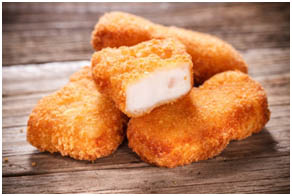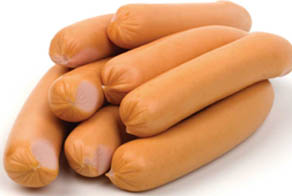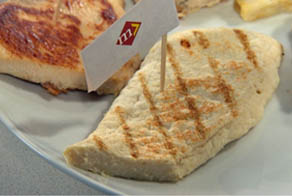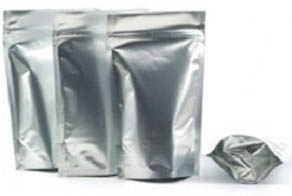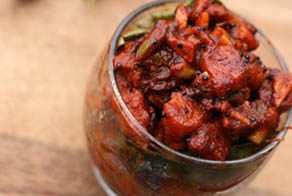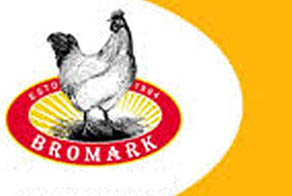 |
|||||||||||||||||||||||||||||||||||||||||||||||||||||||||||||||||||
|
|||||||||||||||||||||||||||||||||||||||||||||||||||||||||||||||||||
| CHICKEN MEAT PRODUCTS AND THEIR MARKETING | |||||||||||||||||||||||||||||||||||||||||||||||||||||||||||||||||||
| Back | |||||||||||||||||||||||||||||||||||||||||||||||||||||||||||||||||||
|
Chicken meat products prepared from ground meat are emulsion based technologies which have the advantages of improved palatability, nutritive value and lesser production cost. Application of processing technology depends on global competitiveness, energy conservation and socioeconomic benefits.
Emulsion Products Emulsion products like chicken meat blocks, nuggets, slices and patties utilizes tough meat, trimmings and edible by-products. The common steps of processing include comminuting/mincing to reduce meat and fat particle size (grinding, mincing, chopping or flaking), mixing with ingredients, making into specific shape, thermal processing and finally packaging. Chicken nuggets are produced by making the meat batter into blocks and cutting the steam cooked and chilled meats into nuggets of different slices. Burgers/patties which contain 70% meat are prepared by mincing the meat, blending with ingredients, forming batter into patties which are cooked at 180°C.
Sausages are made by cutting meat and fat into fine pieces mixed with spices and stuffed into animal intestines and cooked in hot water. Emulsion based sausages are made by grinding, chopping, stuffing, linking, cooking, peeling, slicing and packaging. They are categorized by United States Department of Agriculture (USDA) meat inspection system as fresh, uncooked smoked, cooked, smoked, dry and semidry sausages and luncheon meat, loaves and jellied products.
These are meat products having high protein and low fat made by restructuring dark and white meat from heavy broilers. Excessive fat is trimmed off and other connective tissues are chunked out and formed. Blade tenderization, flaking and bay tumbling are modern methods available to produce tender products. Prepared meats can be used as steaks, cutlets, chops and roasts or they can be freezing stored.
Curing process involves addition of curing agents like salt, sugar, sodium nitrite, sodiumascorbate and sodium polyphosphate to the primal chicken cuts for enhancement of colour, flavour and preservation. Chicken is injected with pickle and dipped in it for faster curing giving a juicy texture. Smoking involves heating, drying, smoking, steaming/ cooking showering, chilling and packaging which give a distinctive flavour. Cured and smoked chicken on the whole has a niche market. Enrobed/ Coated Products Enrobing involves applying an edible coating to the products for improving their texture, flavour, nutritive value, juiciness and tenderness. They act as sealing agents to prevent excess oil absorption. Chicken parts can be enrobed using whole egg liquid (viscous liquid and good batter), curd, flours, corn flakes and bread crumbs which give crispy taste.
Thermal processing of meat destroys microorganisms and enzymes responsible for food spoilage. Thermal processing in metal cans or retort pouches increases shelf life of products and decreases 50% processing time. Some products include traditional Indian curries, soups, Keemas etc. Retort packaged products could be stored for a period of 6 to 12 months.
Value Addition to Edible by Products Edible poultry by products like dressed whole chicken carcass and giblets such as liver, heart, gizzard and neck have good marketing values which are sold as package stuffed into cavity of carcass. Minced skin, gizzard and heart are used in emulsion of chicken products. Ova collected during dressing of layer chickens are used in sausage formulations, patties and kebabs. Chicken soup is another nutritious food that is categorized as low fat food. Channels of marketing Currently more than 75% of the poultry products are reaching the consumers through various channels of distribution leading the consumers to pay more and producers to get fewer margins. Besides, major share of the profit at present goes to the middlemen. At present poultry products are marketed in the following four marketing networks.
Chicken Pickle as an enterprise
As per Agriculture and Processed Foods Products Export Development Authority (APEDA), India has exported 659,304 MT of poultry products for the worth of INR 7,680 million during 2015-16. Majority of the exports are destined for the Middle East. Each year, India exports around 5000 MT of poultry products into Europe, the largest chunk of which is destined for Germany, although the share of the Netherlands has grown significantly over the last few years. The key stakeholders in the Indian poultry market are as follows The key stakeholders in the Indian poultry market are as follows a) Sneha Foods Limited, Telangana b) Srinivasa Hatcheries (SH Group), Telangana c) Balaji Hatcheries, Andhra Pradesh d) V S N Hatcheries, Andhra Pradesh e) Mulpuri Group, Andhra Pradesh f) Venky’s (V H Group), Maharashtra g) Suguna Foods, Tamil Nadu h) R M Group, Haryana. i) Skylark Foods, Haryana j) Komarla Group, Karnataka k) I B Group, Chattisgarh l) Bharati Poultry, West Bengal Relevant trade fairs A wide variety of regional and domestic trade fairs are organized in India throughout the year in the field of poultry. At several of these exhibitions, Netherlands Embassy and Netherlands Business Support Offices (NBSO) organize events, such as Holland pavilion and / or networking events. a) Poultry India 2017 Hitex, Hyderabad, India 22 – 24 November, 2017 www.poultryindia.co.in/ b) Agritech India 2017 BIEC, Bangalore – India 28 – 30 August, 2017 http://agritechindia.com/ Since 2013 more than 12 Dutch companies have participated in Poultry India Show in Hyderabad, India and have bagged good business deals. BROMARK Broiler industry is concerned with poultry meat and layer industry is concerned with egg production. BROMARK (Broiler Marketing Cooperative Society) is a brainchild of late Dr. B. V. Rao is an all India Broiler Farmers' Body registered under the Multi State Cooperative Societies Act in 1994. The objective of the BROMARK is to ensure the gap between producers price and consumer price is reduced and promote the consumption of chicken meat by advertising on its nutritive value.
Prevention of Cruelty to Animals (Regulation of Livestock Markets) Rules, 2017 Guidelines According to latest Prevention of Cruelty to Animals (Regulation of Livestock Markets) Rules, 2017, the guidelines for handling and tying of animals are (1) No person shall handle an animal in an animal market by— (a) lifting it off the ground, other than poultry for weighing propose; (b) dragging it along the ground; (c) suspending it clear of the ground; (d) head, neck, ears, horns, legs, feet, tail, fleece or wing. (2) No person shall— (a) tie up or muzzle any calf; (b) tether an animal by both forelegs and hindlegs in such a way that it will prevent the animal from taking a step forward or backward to ease the discomfort of standing at one place for long hours; (c) tie an animal by head or neck from both the sides which will prevent the animal from moving its head and neck in any direction or attending the self needs such as driving away flies or licking body parts; (d) tie more than one animal using one single rope; (e) use abrasive or sharp materials to tether or tie the animals that may cause injuries; (f) tie any poultry by neck, leg or wing or carry poultry upside down. Institutional Finance for Poultry Development Poultry is one of the fastest growing sectors in the country with an annual growth rate of 12 to 15% in broilers and 5 to 7% in egg production. India has adequate parent stock, hatcheries, equipment manufacturers, etc. required for our poultry industry. For all these achievements, institutional finance from banks also played a major role along with other factors like enterprising farmers, favourable policies of the Government, availability of quality inputs and ever increasing domestic demand for poultry products. During the last three decades poultry production has transformed itself from production by the masses to production for the masses because of high investment cost and inability to withstand wild fluctuation in feed and product prices by small farmers. To cater needs of the poultry sector, Ministry of Agriculture under the aegis of NABARD (National Bank for Agriculture and Rural Development) is providing credit linkage to the farmers through the commercial and regional rural banks and is detailed below. Bank Support Schemes For Poultry Entrepreneurship In India Two major schemes for poultry entrepreneurship in India are 1. Poultry Venture Capital Fund Scheme 2. Poultry Development Scheme Poultry Venture Capital Fund Scheme This scheme is implemented by NABARD through various commercial banks, co-operative banks, regional rural banks and other agencies. All individual entrepreneurs, farmers, Non Govt. Organizations, Companies, groups of organized and unorganized sector are eligible for this scheme The objectives are to establish the poultry breeding farms with low input technology birds and also for creating the necessary infrastructure facilities such as feed godown, feed mixing unit, egg grading, packing and storage for export, retail poultry dressing units etc Features of the scheme This scheme provides financial assistance to open breeding units for low input technology birds and turkey, ducks and other poultry species. Assistance up to Rs 30 lakh is available. Similarly poultry feed unit, feed godown or analytical lab can also be established for which assistance of Rs 16 Lakh is available. Similarly retail poultry dressing units, egg grading, packing and storage for export purpose, transport vehicle and cold room egg/broiler carts, central grower units can be established for which financial assistance is available. Indicative subsidy ceilings under the component of „Entrepreneurship Development and Employment Generation‟ (EDEG) Sub-component - Poultry Venture Capital Fund (PVCF)-EDEG
Eligibility
Repayment Period will depend on the nature of activity and cash flow and will vary between 5- 9 years. Grace period from 6 months to 1 year. How to apply Approach the nearest Veterinary Assistant Surgeon, Block Veterinary Officer or the Chief Animal Husbandry Officer of the concerned District along with:
By centralized banks of India Objective The main objective of financing poultry is to increase egg/meat production by meeting financial requirement of the proponents who are willing to undertake poultry as a subsidiary or main occupation. Purpose
a. Construction of brooder/grower houses, feed godowns, acquisition of electricity and water supply, purchase of cages, purchase of feeders, waterers, feed/egg, trolleys, vaccination equipments ,etc. b. Poultry co-operative may require finance for purchase of feed mixing plant, feed ingredients and for stocking of feeds for their members. c. Integrated layer units will also require finance for construction of broiler houses, purchase of machinery/equipment for dressing of bird, refrigerated storage facilities for dressed birds and refrigerated van for their transport. d. Hatchery units will require finance for egg rooms fumigation room, egg cooling room, room for egg incubators, room for chick sexing as well as and vaccination and packing room. e. Larger poultry units may also require finance for purchase of air conditioners, stand-by generator. Eligibility Individual farmers/agricultural laborers who are experienced/trained in poultry management are taking up poultry farming as a subsidiary occupation.Individual registered partnership firms, limited companies, etc., are eligible for bank credit for large poultry units. These units should have trained/ technically qualified personnel for running the unit. Technical feasibility The following aspects should be taken into account while assessing the technical feasibility for a poultry project: a. Sustainability of climate; b. Availability of day old chicks, feed, etc; c. Requirement of housing and equipments; d. Availability of electric power; e. Veterinary care; f. Marketing arrangements; g. Experience of the proponent/availability of the trained/technically qualified personnel for running the unit etc. Financial viability The assessment of financial viability of poultry units should include reasonableness of cost of various items of the scheme. Cost benefits analysis of the scheme should be worked out over the scheme period to find out net income generation vis-à-vis servicing of the debt apart from the entrepreneur getting a fair amount of return on the investment. Subsidies available to small/marginal farmers, agricultural labourers, scheduled casts and scheduled tribes under various programmes should be taken into account while studying the financial viability of the scheme. Quantum of finance The amount of finance will depend upon the type and size of the poultry unit and the fixed costs and the working capital requirement during the gestation period. Working capital for the first 6 to 7 months in case of layer farms, 2 to 2.5 months in case of broiler farms and normally 6 to 7 months for hatcheries should be capitalized and included in the project cost. Margin For marginal/small farmers, agricultural laborers and scheduled castes/scheduled tribes and other weaker sections, subsidy available from various sources to be treated as margin. For others, 15 to 25% depending upon the financial capability of the proponent and size of the project. Type of facility Term loan Security Demand Promissory Note (L-434),Composite Agreement for Hypothecation (CHA-1/CHA-2),Borrower’s loan application should clearly state the purpose for which the advance is sought and being an integral part of the documents, a copy of such application must be attached to the Agreement for Hypothecation.L-515 declaration as to relationship with Director/Officials,L-516 or Annex the clauses on non-diversion of funds and securitization enclosed to Br. Cir.No.97/186 dated 08.03.2004 with CH I/CHA-II/CHA-IVEquitable or legal mortgage or deed of declaration of land/superstructure, as appropriate where the limit exceeds Rs.50000/- (legal mortgage of land is to be taken in form CHA-4),Letter of Guarantee from a guarantor wherever considered necessary in the limit above Rs.50000/-.(CHA-3). Insurance Comprehensive insurance of birds covering diseases to be obtained for poultry development under all government sponsored schemes, small and medium poultry farms having bird strength upto 10,000/-.In respect of commercial farms and hatchery units having fully automated management system or environmentally controlled management, obtention of comprehensive insurance of birds covering diseases be waived, irrespective of its size.Comprehensive insurance of poultry birds covering diseases may not be insisted upon in respect of large poultry farms and hatchery farms with strength of birds above 10,000, obtention of such insurance be left to the discretion of the borrower/s.Obtention of regular fire and strikes, riots, civil commotion (SRCC) comprehensive insurance policy for poultry structure, hatchery building, other civil work, machinery, equipment, feed mill, stock of feeds, medicines, vehicles, etc. financed under poultry development schemes. Disbursement The execution of the scheme should be planned in a phased manner. Disbursement should be in accordance with the progress made in execution of different items of the scheme. At every stage of disbursement, the progress of the work should be verified by conducting post-disbursement inspections. As far as possible the loan amount should be disbursed directly to the concerned contractor/dealer/supplier/agency against proper bills/receipt and statement of completion from the borrower. Repayment Layer Farms: Monthly installments after a gestation period of 6-7 months after purchase of day old chicks. Broiler Farms: Monthly or quarterly depending upon the size of the unit and income generation pattern after a gestation period of 3 months after purchase of day old chicks. Hatchery Units: Monthly installments to start 7 to 8 months after the first purchase of parent stock as day old chicks. |
|||||||||||||||||||||||||||||||||||||||||||||||||||||||||||||||||||
| Back | |||||||||||||||||||||||||||||||||||||||||||||||||||||||||||||||||||
|
|||||||||||||||||||||||||||||||||||||||||||||||||||||||||||||||||||
| Scroll | |||||||||||||||||||||||||||||||||||||||||||||||||||||||||||||||||||
| Division of Veterinary and Animal Husbandry Extension Education Faculty of Veterinary Sciences and Animal Husbandry, R.S. Pura, SKUAST Jammu | |||||||||||||||||||||||||||||||||||||||||||||||||||||||||||||||||||
